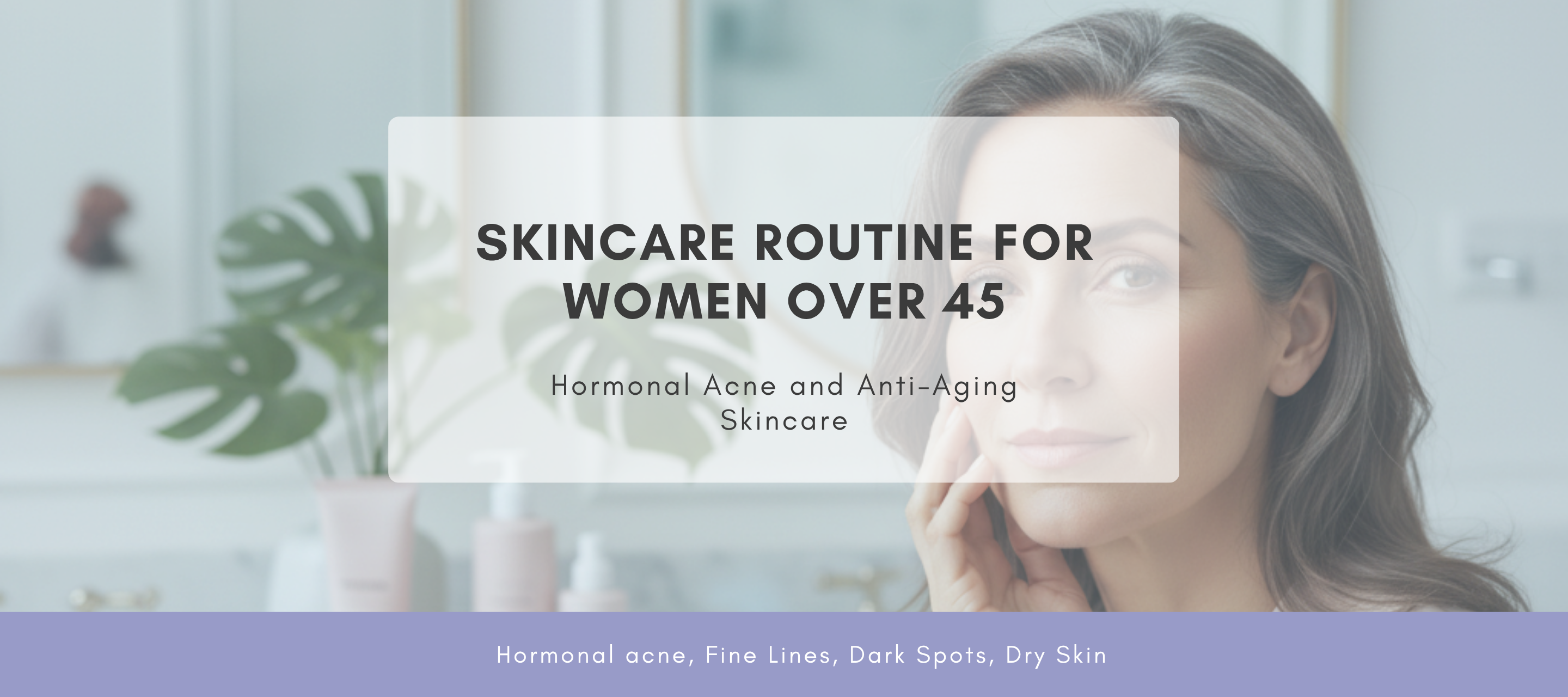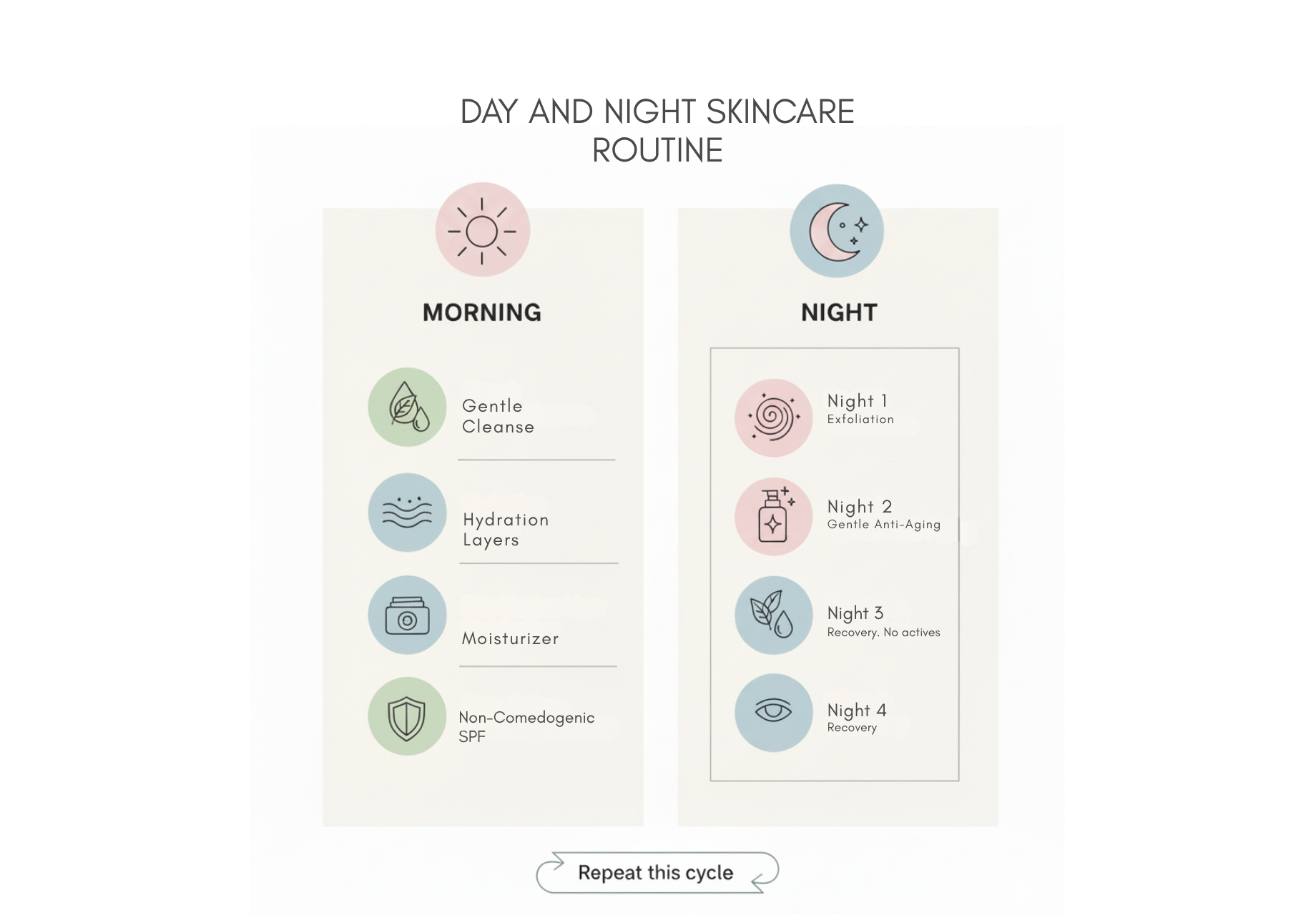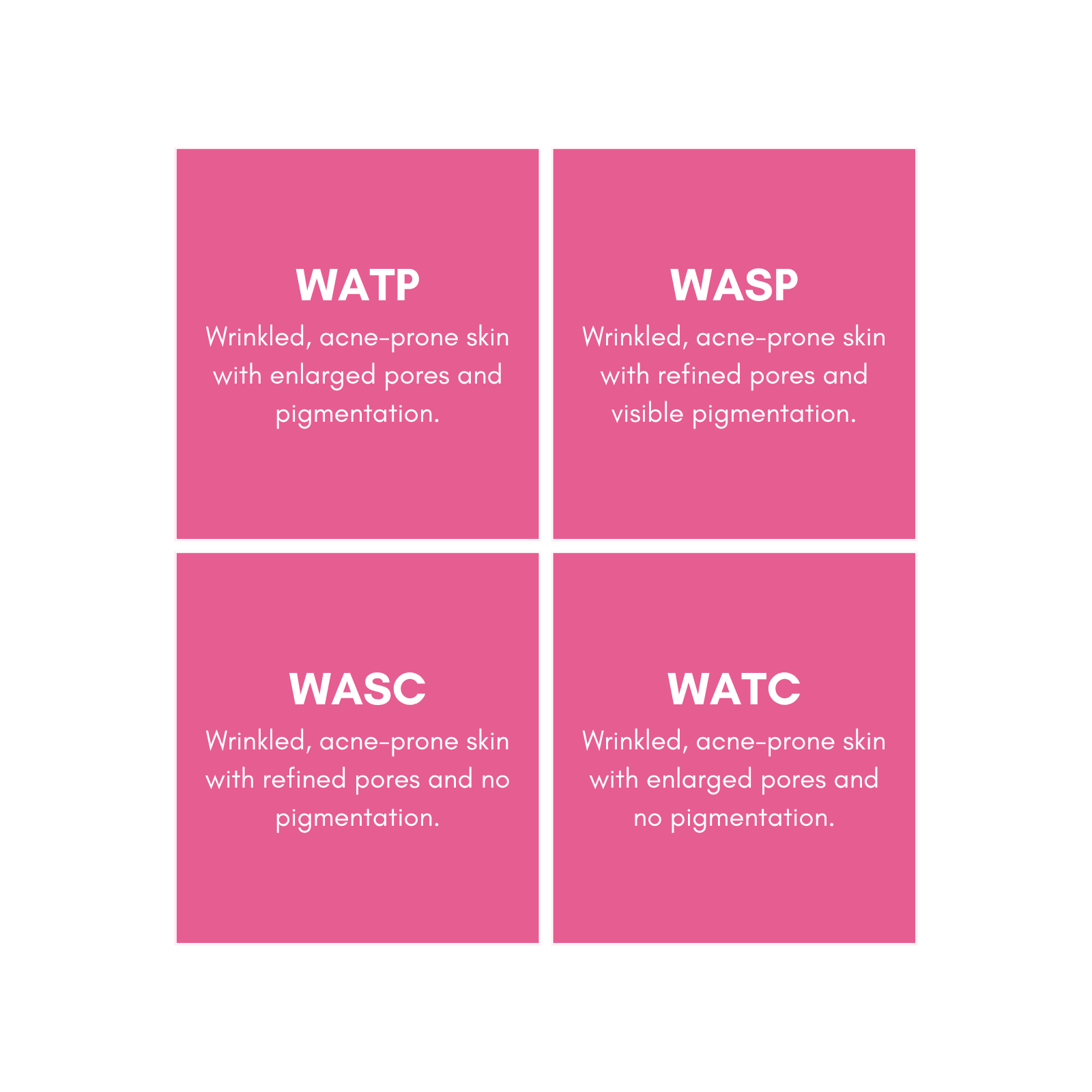
Skincare Routine for Women Over 45: Hormonal Acne and Anti-Aging Skincare
If you’re reading this, you’ve likely found yourself right where many women are: you’re dealing with the return of frustrating, deep hormonal acne just as you’re starting to focus on fine lines and wrinkles and loss of elasticity. It feels unfair, a cruel joke of nature that brings back the pimples of your youth alongside the signs of aging.
You are not alone.
As women enter their 40s and 50s, hormonal shifts change the very nature of their skin. Acne at this age is different from teenage acne. It’s less about surface oiliness and more about deep, inflamed cysts triggered by shifting estrogen and progesterone, often along the jawline, chin and neck. Crucially, mature aging skin is also dry skin and slower to heal, so the harsh, stripping skin care products of the past will only speed up the aging process. This is why finding the best skincare for women over 40 requires a gentle touch.
Soothing and Hydrating Ingredients To Look For
When it comes to treating both acne and signs of aging, the right ingredients make all the difference. Instead of harsh formulas that strip your skin, focus on gentle yet effective staples. Many factors influence your skin health, but choosing the right ingredients is the most important.
These soothing botanicals and hydration boosters calm irritation, protect your skin barrier, and keep your complexion plump, healthy, and youthful.
Calming and Clearing Ingredients To Focus On
Centella Asiatica (Cica):
The ultimate soothing ingredient. Cica, also known as Tiger Grass, is an amazing anti-inflammatory that reduces redness and accelerates wound healing, a must for preventing post-acne scarring and improving skin texture. Look for it in toners and recovery creams.
Mugwort:
A superhero ingredient for sensitive, inflamed skin. Mugwort has antibacterial properties and calms irritation without drying out the skin, making it perfect for hormonal acne.
Minimal Salicylic Acid (BHA):
This is your targeted ingredient for the small blackheads on your chin and the little bumps on your forehead (closed comedones). This form of salicylic acid will gently remove dead skin cells from the upper layers of the skin without overly sensitizing your delicate skin.
For boosted anti-aging benefits and a more youthful appearance, consider adding a Vitamin C serum to your morning routine.
To shop for serums featuring these exact ingredients, see our full guide on Best Korean Serums for Every Skin Concern.
Barrier Defense and Hydrating Ingredients to Focus On
For decades, we were told that acne-prone skin needed to be dried out. K-Beauty knows this is a myth, especially for the 45+ age group.
Dry skin is the enemy of anti-aging.
When your skin barrier is dry and damaged, it reacts to protect itself, often by triggering the inflammation that feeds hormonal acne. When you restore the skin barrier, you create a healthy, calm environment where breakouts are less likely to occur and fine lines are plumped and softened for a youthful-looking skin.
Ceramides:
These are the essential lipids that make up your skin barrier. Replenishing ceramides strengthens the skin, locking in moisture and preventing environmental irritants from causing inflammation.
Snail Mucin:
Snail Mucin is super healing, helps boost collagen and calms irritated skin. It’s a great, gentle multitasker for both acne and aging concerns.
Hyaluronic Acid:
Look for this ingredient in your toner and serum for added hydration and plumpness. Hyaluronic acid serum is crucial for retaining moisture.
How To Structure a Day and Night Routine for Dual Concerns?
The secret to managing these dual concerns (acne and aging) is a strict Dual Skincare Routine that separates your aggressive targeted treatments from your daily sun protection.

AM Routine: Protection and Hydration
Your morning ritual is all about calming, hydrating and building a strong defense against the day’s stressors. It also helps boost elastin production throughout the day.
Step 1: Gentle Cleanse.
Use a low-pH, creamy, or mild cleanser to remove dirt without stripping your skin. This facial cleanser supports healthy skin.
Step 2: Hydration Layers.
Start with a soothing, watery toner (with Cica or Mugwort) followed by a hydrating essence and then your lightweight serum. This is also the best time to apply a few drops of a vitamin C serum to fight dark spots and boost collagen for a youthful appearance.
Step 3: Lightweight Moisturizer: This can be your face cream for the day.
→ For Combination Skin: Choose a lightweight, gel-based moisturizer that still contains ceramides. This is your day cream.
→ For Oily Skin: Look for a mattifying, oil-free gel with hyaluronic acid that won't clog pores.
→ For Dry Skin: Opt for a richer cream with ceramides or shea butter to deeply nourish and repair your skin barrier
Step 4: Non-Comedogenic SPF (Crucial!).
Look for broad spectrum spf labeled "non-comedogenic" to ensure it won’t clog your pores or trigger inflammation. Daily sunscreen is the single most important anti aging step to protect your skin from skin cancer and sun spots.
PM Routine: Focus on Repair and Skin Cycling.
The evening is when your skin focuses on repair. The best way to introduce your powerful anti aging treatments without causing irritation is through Skin Cycling (a four-night pattern for your nighttime routine): Ensure you get enough sleep to maximize overnight repair.
Night 1: Exfoliation.
Use a gentle chemical exfoliant (like a low-concentration Lactic or Glycolic Acid, or your low BHA salicylic acid serum) to gently remove dead skin cells. Avoid scrubs, grainy cleansers, or brushes that can be too harsh on your skin.
Night 2: Gentle Anti-Aging.
Apply a Bakuchiol serum, a natural, plant-based alternative to retinol. This ingredient boosts cell turnover to help fight acne and stimulates collagen production to reduce fine lines—without the irritation that traditional retinoids can cause. Start slowly and observe how your skin responds. You can also apply an eye cream around the delicate eye area to target dark circles and crow’s feet.
Night 3: Recovery. No actives!
Focus entirely on soothing and skin barrier repair. Use moisturizer products rich in Ceramides, Centella, and Snail Mucin.
Night 4: Recovery.
Another night of nothing but deep hydration and repair. This second recovery night is essential for mature, sensitive skin to prevent irritation and build resilience. Apply moisturizer generously.
Repeat this cycle.
Finding Your Perfect Match: How Does the LuluTI System Customize Your Routine?
While the dual skincare routine we've outlined is a wonderful foundation, mature skin in its 40s and 50s demands precision and attention to detail. Moving from general advice to a truly targeted routine is the key to seeing lasting results for both aging and acne.
This is where the LuluTI system comes in.
These LuluTI codes are designed to help categorize the specific, nuanced needs of mature, acne-prone skin. With this precision, a tailored list of products are selected for your unique skin type, giving you a highly effective skincare routine that simply works.
The four core LuluTI types include:
WATP: Wrinkled, acne-prone skin with enlarged pores and pigmentation
WASP: Wrinkled, acne-prone skin with refined pores and visible pigmentation.
WASC: Wrinkled, acne-prone skin with refined pores and no pigmentation.
WATC: Wrinkled, acne-prone skin with enlarged pores and clear skin tone (no pigmentation).
To fully understand your options and pinpoint the precise LuluTI for your skin, you first need to know where your skin fits! Try our AI Skin Analysis to instantly find your LuluTI skin code.

When Will I See Results?
The most effective ingredient in any skincare routine is consistency. Hormonal acne is cyclical, and the process of skin barrier repair and collagen production takes time, often 8 to 12 weeks, to show significant results. Be patient with your skin, treat it kindly, and know that you are finally using a routine that works to improve your skin's appearance and give it a more youthful appearance.
Conquering hormonal acne while fighting fine lines comes down to balance, patience, and choosing kindness over harshness. The K-Beauty dual routine strategy allows you to meet your skin where it is today: mature, sensitive, and actively repairing, by prioritizing hydration and strategic use of actives for any skin concerns.
FAQs
1. Which is more important for anti-aging: Exfoliation or Sunscreen?
Sunscreen is the most critical anti-aging product. UV exposure is the leading cause of wrinkles and sunspots. Using actives like exfoliants makes your skin more sensitive to the sun. Daily application of a broad spectrum, non-comedogenic SPF is non-negotiable for protecting your skin investment and preventing new damage.
2. The 'Gentle Cleanse' recommendation is new to me. Why can't I use a stronger acne cleanser?
Mature skin is typically dry and prone to barrier damage. Harsh cleansers strip the skin, triggering inflammation that feeds hormonal acne and emphasizes fine lines. Use a low-pH, creamy, or mild cleanser to clean without damaging your moisture barrier, ensuring your active treatments work effectively later.
3. I'm concerned about 'Hydration Layers.' Isn't too much moisture bad for acne?
No, too much moisture isn't bad for mature acne; in fact, it's essential. Teen acne thrives on excess sebum the skin's oil which clogs pores. However, mature skin needs hydration to heal and minimize fine lines.
Hydration Layers work because they address dehydration the lack of water in your skin. Sebum (oil), is acting only as a sealant. When mature skin is dehydrated, this dry state triggers inflammation and a compensatory rush of poor-quality sebum, which worsens acne. Water-attracting ingredients, like Hyaluronic Acid or Snail Mucin restore the water the skin needs, which calms the skin and stops the cycle of producing too much oil.
4. Where does an ingredient like Niacinamide fit into this routine?
Niacinamide (Vitamin B3) is excellent for both concerns. It calms inflammation (good for acne), reduces pore size, and strengthens the skin barrier (anti-aging). Use it in the Morning Hydration Layers (Step 2) or on Recovery Nights (Night 3 & 4) as a serum, before moisturizer.
5. How do I know if I'm applying my serums in the correct order?
A simple rule is to layer from thinnest to thickest consistency. Watery products absorb fastest.
- Toner/Essence (wateriest)
- Serums (lighter texture, like Vitamin C or Niacinamide)
- Moisturizer/Cream (thickest) Wait 30-60 seconds between layers to prevent pilling.

